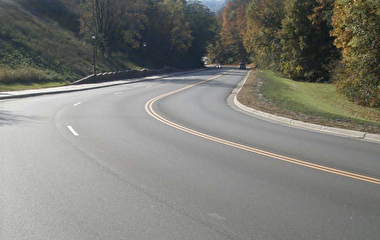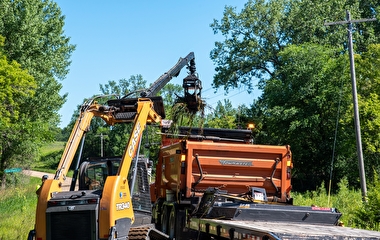Researchers from the University of Minnesota Duluth studied a material called fiber-reinforced concrete (FRC) that offers promise as a durable, cost-effective repair option for concrete pavement. The goal of the project was to develop best practices for using FRC in pavement—such as how to select the right fibers for a specific project and how many fibers should be added to a mix—and to create guidelines that paving agencies might refer to when pouring FRC concrete.
The material is made by adding steel or polypropylene fibers to plain concrete. Once the concrete hardens, these “structural fibers” serve the dual purpose of transferring vehicle weight from one concrete slab to the next and holding cracks and joints tightly together.
FRC is commonly used in thin concrete overlays, which are 4- to 6-inch slabs of concrete poured over existing, worn-down concrete or asphalt as a cost-effective fix. “FRC is useful because it increases the life of the roadways and is cost-effective in the long run,” says Manik Barman, assistant professor in the civil engineering department and the study’s principal investigator.
The project consisted of a literature review, survey, series of laboratory tests, and analysis. “We wanted to determine the optimal physical characteristics of fibers, the amount that should be mixed in the concrete, and products currently not on the approved products list that may be effective,” Barman says.
The literature review and survey were conducted to understand how FRC is already used by paving agencies across the country. The survey, which targeted state transportation agencies identified as leading users of FRC, found that most—94 percent—of FRC overlays are made using synthetic fibers rather than steel because synthetic fibers are lighter, less expensive, resistant to corrosion, and easier to mix.
The lab tests and analysis then went on to determine which fiber geometries, lengths, and stiffnesses are the most effective. For example, fibers that are laterally stiffer, embossed, twisted, and crimped proved to be more effective than straight, flat ones. The researchers recommend fiber lengths between 1.5 and 2.5 inches depending on traffic volume and design life.
“The project is one step forward in understanding fibers’ contribution in concrete pavements or overlays,” Barman says. The study was funded by the Minnesota Department of Transportation (MnDOT) and the Local Road Research Board.
“The study indicates that fibers can provide an alternative to dowels in thinner concrete pavements,” says Maria Masten, concrete engineer with MnDOT’s Office of Materials and Road Research. For many concrete pavements, designers recommend dowel bars to assist load transfer across slab joints, but MnDOT has found that dowel bars are not effective in a thin overlay.
Barman says more research is needed to determine best practices for using FRC. “Paving agencies now know which fibers to use, but they need to fine-tune the recipe of the concrete so that durable and long-lasting concretes can be produced,” he explains. “Agencies need guidelines for other ingredients of FRC such as air content, workability, compaction, and shrinkage.” Researchers will begin this work—also funded by MnDOT—in July 2019.



